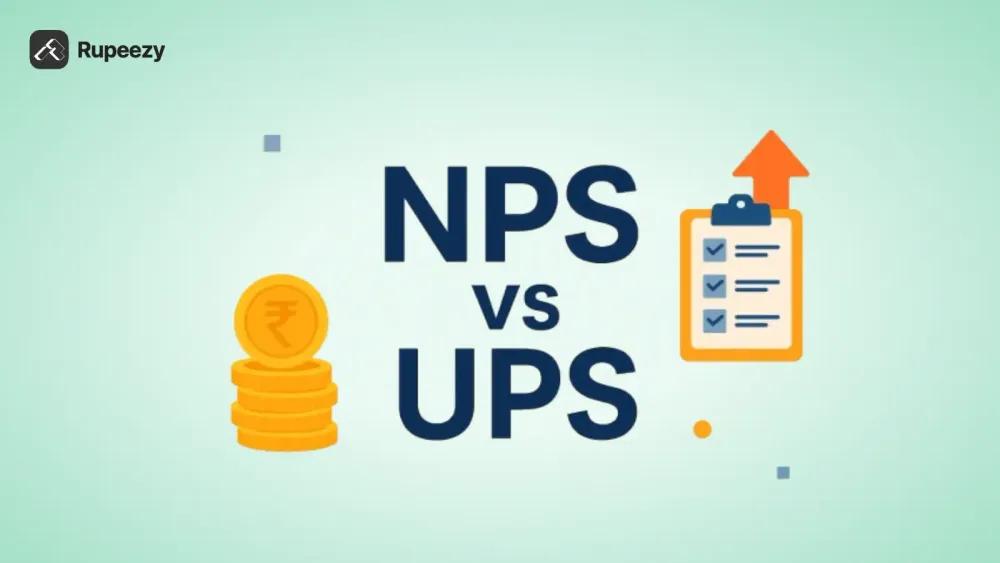NPS vs UPS: Which is Better in 2025 India?


00:00 / 00:00
Retirement planning in India is no longer limited to government employees. Today, everyone wants a stable income and a secure life as they age. In this context, two names are most frequently discussed: NPS and UPS. Both schemes aim to provide financial stability after retirement, but their benefits and working methods differ significantly. In this blog, we'll explain in simple terms which is better, NPS vs. UPS, and which plan is right for whom.
What is NPS (National Pension System)?
The National Pension System (NPS) is a long-term retirement scheme of the Government of India, regulated by the Pension Fund Regulatory and Development Authority (PFRDA). It is a voluntary investment plan aimed at providing regular income and financial security to individuals after retirement. Investors in the NPS contribute to a substantial retirement fund, which is invested in market-linked investment options such as equities, bonds, and government securities. This has the potential to generate better returns than traditional pension plans.
Eligibility
NPS is open to almost every Indian citizen.
Age Limit: 18 to 70 years
Both Indian citizens (residents and NRIs) can invest.
Only individuals (not including HUFs or corporate bodies).
Completing the KYC process requires PAN, Aadhaar, and bank account details are required.
Types of NPS Accounts
NPS offers two types of accounts, which can be chosen as per the needs of the investor:
Account Type | Objective | Withdrawal Rules | Tax Benefit |
Tier I Account | Main account for retirement savings | Partial withdrawals limited | Tax exemption under 80C and 80CCD(1B) |
Tier II Account | For additional voluntary savings | Withdrawals are possible at any time | No tax benefits |
Investment Structure
Investment Options | Description | Risk Level |
Equity (E) | Investing in the stock market | High |
Corporate Bonds (C) | Debentures of corporate companies | Moderate |
Government Securities (G) | Government bonds and securities | Low |
Alternative Assets (A) | REITs, InvITs, etc. | Moderate–High |
What is UPS (Universal Pension Scheme)?
The Unified Pension Scheme (UPS) is a new pension scheme of the Government of India, implemented from April 1, 2025. This scheme has been launched specifically for central government employees to provide them with a guaranteed pension. The objective of UPS is to provide every employee with a stable and assured income after retirement. It has been introduced as an alternative to the National Pension System (NPS) to provide employees with a market-risk-free and predictable pension benefit.
Eligibility
UPS is currently available only for central government employees.
Effective Date: Effective April 1, 2025
Eligible Employees: All central government employees who are NPS members and are in service after this date.
Service Period: Minimum 10 years of qualifying service is mandatory.
Those with 25 years of service or more will receive the full pension (50%).
Retired NPS subscribers (as of March 31, 2025) can also receive some UPS benefits if they have completed 10 years of service.
Types of UPS Benefits
UPS is not like an investment account but is based on the Defined Pension Model, where benefits depend on your service period and salary.
Type of benefit | Description | Eligibility |
Monthly Pension | Assured pension every month after retirement | Minimum 10 years of service |
Family Pension | 60% pension to the spouse on the death of the employee | All eligible employees |
Lump Sum Benefit | 1/10th Basic Pay + DA for every six months of service | On retirement |
Dearness Relief (DR) | Increase in pension as per the inflation rate | Applicable to all pensioners |
Contribution Structure
The contribution system in UPS is pre-determined so that both the government and the employees work together to ensure a future pension.
Party | Contribution Percentage | Calculation base |
Employee | 10% | Basic Pay + Dearness Allowance (DA) |
Employer | 18.5% | Basic Pay + DA |
Pension and Returns
The pension received after retirement in UPS is defined, that is, it is not linked to the market.
Service Period | Pension Rate | Description |
25 years or more | 50% of the average basic pay of the last 12 months | Full pension |
10 to 25 years | on a pro-rata basis | Partial pension |
less than 10 years | Not eligible for pension | Contributions may be refunded |
Withdrawal & Exit Rules
Situation | Rule | Effect |
Retirement (at 60 years) | Assured pension on completion of the service period | Monthly Payment |
Voluntary Retirement (VRS) | Permitted after 20 years, but full benefit after 25 years | proportionate pension |
Less than 10 years of service | No pension under UPS | Contribution withdrawal possible |
After death | 60% pension to spouse | Family Safety |
Key Differences Between NPS and UPS in India 2025
Parameters | NPS (National Pension System) | UPS (Unified Pension Scheme) |
Launch Year | 2004 (mandatory for central government employees) | 2025 (applicable as an alternative to NPS) |
Regulatory Body | PFRDA (Pension Fund Regulatory & Development Authority) | Government of India, Ministry of Finance |
Target Group | All Indian citizens, private and government employees | Central Government employees only (NPS members) |
Type of plan | Defined Contribution | Defined Benefit (Fixed Pension Based) |
Returns | Market-linked average 8%-12% annually | Fixed pension based on service and salary |
Risk Level | Moderate to high as per equity and bond investments | Very low with government guarantee |
Contribution | Employee: 10%, Employer: 14% (Basic + DA) | Employee: 10%, Government: 18.5% (Basic + DA) |
Pension Formula | Investment value × Market return | Based on the length of service and the last pay fixed |
Minimum pension | Not sure, depends on the market | ?10,000 per month (after 10 years of service) |
Full pension (50%) condition | Not applicable | 25 years or more of service required |
Withdrawal | 60% tax-free, 40% subsidy on mandatory purchase | Regular pension, no annuity purchase |
Tax Benefits | Exemption under sections 80C, 80CCD(1B), 80CCD(2) | Limited, as per the guidelines laid down by the government |
Flexibility | More Choose a fund manager and asset allocation | Limited rules set by the government |
Family Pension | Under the Anty option only | 60% pension to spouse |
DA Relief | Not applicable | Automatic inflation adjustment as per AICPI-IW |
Control of risk and returns | Depends on the investor's decision | Government guaranteed, no market risk |
Common Myths About NPS and UPS
There are many misconceptions surrounding retirement plans in India, especially those related to NPS and UPS. Below are some major myths and their truths explained in simple terms:
Myth 1: UPS is always better than NPS
Many people believe that UPS is more beneficial than NPS because it offers a guaranteed pension.
Reality: UPS is a defined benefit scheme that offers a fixed pension, but its growth potential is limited. NPS, on the other hand, is market-linked, so it can offer higher returns in the long term.
Myth 2: NPS is too risky
Many investors think that NPS, with its equity investments, could lead to a loss of money.
Reality: In NPS, the investor decides for themselves how much to invest in equities and how much in bonds or government securities. This means that risk can be completely controlled.
Myth 3: UPS is only for low-income groups
It is often believed that UPS is only for low-paid government employees.
Reality: UPS is open to all central government employees whose service falls under the UPS eligibility criteria. It has no relation to salary level.
Myth 4: The government contributes more to UPS
Many people think that the government contributes more to UPS, and therefore it is better.
Reality: The government contributes 18.5% to UPS, compared to 14% to NPS. However, due to the fixed pension in UPS, there is no compounding benefit, whereas NPS offers market-linked growth.
Myth 5: You cannot switch back to NPS after choosing UPS
Employees have the misconception that once they choose UPS, there is no way back.
Reality : The government has introduced a one-time, one-way switch in 2025, allowing employees to switch from UPS to NPS. (Source: Economic Times, June 2025)
Myth 6: The tax policy of both NPS and UPS is the same
Many people believe that the same tax rules apply to both schemes.
Reality: Tax exemptions in NPS are clearly available under sections 80CCD(1), 80CCD(1B), and 80CCD(2). The tax guidelines for UPS have not yet been finalized, so there is a possibility of change.
Myth 7: The pension amount in UPS is fixed and cannot be increased
People think that the pension in UPS is fixed and will never increase.
Reality: UPS provides Dearness Relief (DA), which will increase the pension according to the inflation index (AICPI-IW).
Conclusion
Choosing a retirement plan isn't just an investment decision; it's a lifelong decision about stability. Both NPS and UPS serve their respective purposes. NPS offers long-term capital appreciation and tax benefits, while UPS ensures the security of a stable and guaranteed pension. If you're market-savvy, NPS is a better option, and if you're looking for a fixed income without risk, UPS is more suitable. The right choice depends on your financial thinking and future priorities.
FAQs
Q1. What is the main difference between NPS and UPS?
NPS is a market-linked scheme with variable returns, while UPS is a fixed pension plan with guaranteed income.
Q2. Can government employees switch from NPS to UPS?
Yes, the government has given a one-time option to switch from NPS to UPS in 2025.
Q3. Which gives better returns, NPS or UPS?
NPS gives higher returns in the long run because it is market-linked, while UPS has fixed returns.
Q4. Is UPS available for private employees?
No, UPS is only applicable to central government employees.
Q5. Which is safer: NPS or UPS?
UPS is a fully government-guaranteed scheme, so it is considered safer.
Q6. Can NPS beat inflation in the long run?
Yes, because it involves equity investment, which can give better returns than inflation.
The content on this blog is for educational purposes only and should not be considered investment advice. While we strive for accuracy, some information may contain errors or delays in updates.
Mentions of stocks or investment products are solely for informational purposes and do not constitute recommendations. Investors should conduct their own research before making any decisions.
Investing in financial markets are subject to market risks, and past performance does not guarantee future results. It is advisable to consult a qualified financial professional, review official documents, and verify information independently before making investment decisions.

All Category










